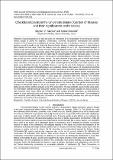Checklist of plants in the University Botanic Garden of Maseno and their significances to the society
Abstract/
A botanical garden is an area set aside and maintained by an organization for growing and studying
various groups of plants for aesthetic, conservation, economic, educational, recreational and scientific
purposes. A lot of research on checklisting of vascular plants has been or is being carried out in various botanic
gardens around the world. At the University Botanic Garden Maseno, no elaborate research on check listing of
plant species has been done. There has scarcely been any attempt to carry out phytochemical analysis on
various in situ and ex situ plants conserved at the University Botanic Garden and no research has been done to
document the educational and economic values of the garden. Moreover, the rate at which the plant biodiversity
is being cleared is alarming, and calls for urgent need of conserving plants of high economic values. It is on the
basis of such need that the study was carried out at the University Botanic Garden, Maseno (UBGM). The study
was carried out over a period of eleven months. The main objective of the study was to identify and provide
checklist of plants conserved at the University Botanic Garden, Maseno. During field survey observations were
made, interviews conducted and notes taken on plant morphological characteristics and habit of plants. Some
plants were identified through the available literature, and by the aid of the herbarium specimens in the
University botanic garden. Unidentified plants were collected, pressed, dried, preserved, mounted and identified
at the National museums of Kenya herbarium. Voucher specimens of the same were deposited in the University
botanic garden herbarium. It was found that there are 235 plant species in the botanic garden, belonging to 66
families. For each plant species, species name, author name(s), common name (where available), family, habit
and use of plant species were provided. A plant usage was considered valid when cited by three different
respondents. Interviews based on the questionnaire were administered to members of the surrounding
community and workers in the garden. The questionnaires were also issued to the botany students and staff of
the University. Through it, economic and educational values of the University botanic garden and conservation
strategies of threatened plants ex situ in the garden were gathered. The data collected was presented using
tables and pie-charts, and then analysed using SPSS programme. The data collected was presented using tables.
The information collected through annotated checklist will be used to provide database of vascular plants of
high economic value found within the University Botanic Garden, provide information on phytochemicals
present in some medicinal plants and hence need for sustainable biodiversity conservation. The knowledge of
such medicinal plants will provide vital information to the local community members who still rely on herbal
medicine for the treatment of most diseases.
Collections
- Department of Botany [232]

